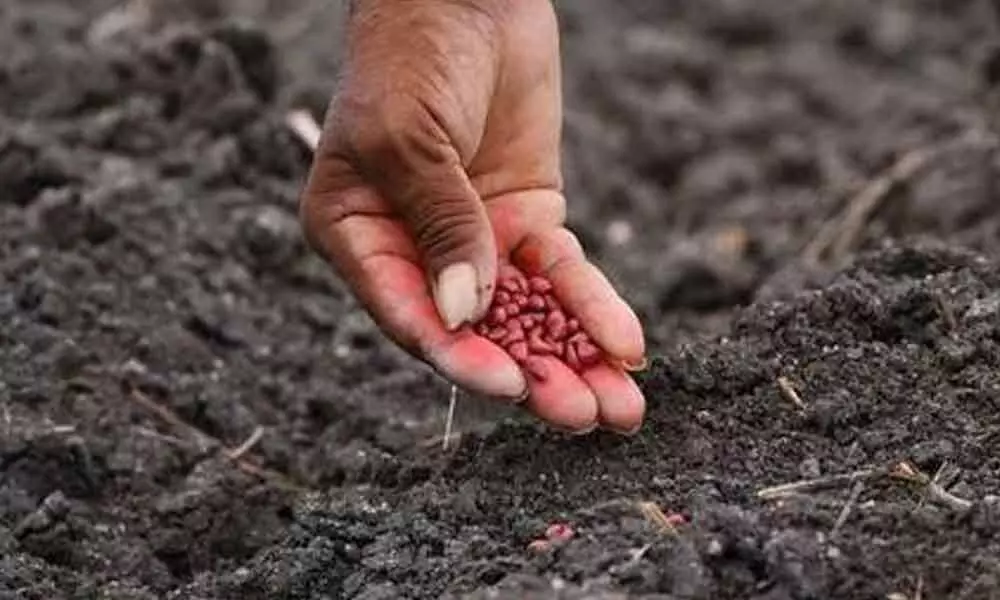Live
- Achoo! City faces spike in flu, cold, cough cases
- CPM demands TTD to allocate Rs 100 cr every year for Tirupati development
- Oppn pushes for debate on Adani issue, Manipur
- Guv invites Soren to form govt
- Mahayuti allies go into huddle to pick Maha CM
- Rachakonda police issues prohibitory orders in view of TGPSC tests
- Minister urged to revive defunct SKIAD institute
- SBI rescues sr citizen from `46L cyber fraud
- Are strict laws needed to ensure MLAs attend Assembly sessions?
- 12-yr-old dies of electrocution
Just In
Anantapur: Spurious groundnut seed hits yield, quality


Spurious groundnut seed hits yield, quality
As kharif season has begun with the onset of monsoon, the rampant circulation of spurious seeds versus poor germination has become a cause for concern to farmers across the district.
Anantapur: As kharif season has begun with the onset of monsoon, the rampant circulation of spurious seeds versus poor germination has become a cause for concern to farmers across the district.
Farmers were overjoyed when the southwest monsoon brought rains abundantly, but it has turned into a woe with the groundnut crop sown in close to 5 lakh hectares in the district getting badly affected due to water stagnation or excess mixture in the soil.
The scientists at the Agriculture Research Station, Rekulakunta, have tested the crops sown in June, July and August to assess the likely yield, which brought the bad news that the average final yield is likely to be below 500 kg per hectare.
"Commercially to break even for a farmer, at least 700 kg per hectare is what we look forward to. With 532 mm rainfall recorded from June 1 till August 20, the groundnut crop has been badly damaged. We witnessed some lanky green crops, but with no pod formation or a very small one.
Most of the crop sown in July had suffered a change of leaf colour from green to yellow with leaf spot disease setting in. Sucking pests 'jassids' attacked crop in a large area.
POOR FLOWERING
The groundnut crop sown in June and July (46,850 hectares and 4,09,254 hectares respectively) witnessed thick vegetative growth with poor flowering and formation of pegs and conversion of pegs into pods.
A high incidence of leaf spots and sucking pest attacks were seen on a large scale on K-6 variety of seed supplied on subsidy by the government as that is the most popular variety in the district. In August it was sown in 36,250 hectares.
In Gooty, a farmer Saradamma, who had sown in 10 acres has already incurred 1.5 lakh loss and many others are facing a similar fate.
In the last 25 years, profitable groundnut yields were recorded only in seven years – 1995 (1,310 kg/ha), 1996 (711), 1998 (1,145), 2000 (1,116), 2004 (798), 2007 (1,258), 2017 (992), 2018(1240), 2019 (1,250).
Dr M Suresh Babu and Goutham Buddha members of farmers producers organisation(FPO), who jointly studied the climatic vagaries the crop is subjected to, suggests diversification of crops to avoid losses.
Of the seeds that are distributed on subsidy, through the Department of Agriculture in Anantapur district, only 20 per cent are certified seeds and the rest are truthful seeds. In 2021 kharif, of the 5.8-lakh quintals of seed distributed by the department of agriculture only one-lakh quintals were certified seeds and the rest are truthful seeds.
Truthful seeds are those that are not subjected to the seed certification process but have a label provided by the seed producers themselves, indicating the germination and purity levels of seed. In other words, truthful seeds are those whose quality is vouched for by the producers themselves and not by the state seed certifying agency.
The system of seed production and distribution with regard to groundnut in Anantapur district has several implications for seed quality and thereby on yield.
Seed production in the formal sector, that is, groundnut produced for purposes of seed by registered farmers or in seed villages, plays a very limited role in the overall seed requirement of district.
While one-third of seed requirement of farmers is met by the agricultural department, only a small portion of it, say, about 20 percent, is produced as certified seeds. The bulk of seed requirement is met by farmers themselves either by way of their own retained seeds or from other farmers or friends or relatives or from middlemen who deal with it.
Thus, groundnut produced for seed purpose gets diverted for consumption purpose thereby reducing the availability of good quality seeds. Moreover, this practice is also results in a lower seed multiplication ratio for groundnut.

© 2024 Hyderabad Media House Limited/The Hans India. All rights reserved. Powered by hocalwire.com






